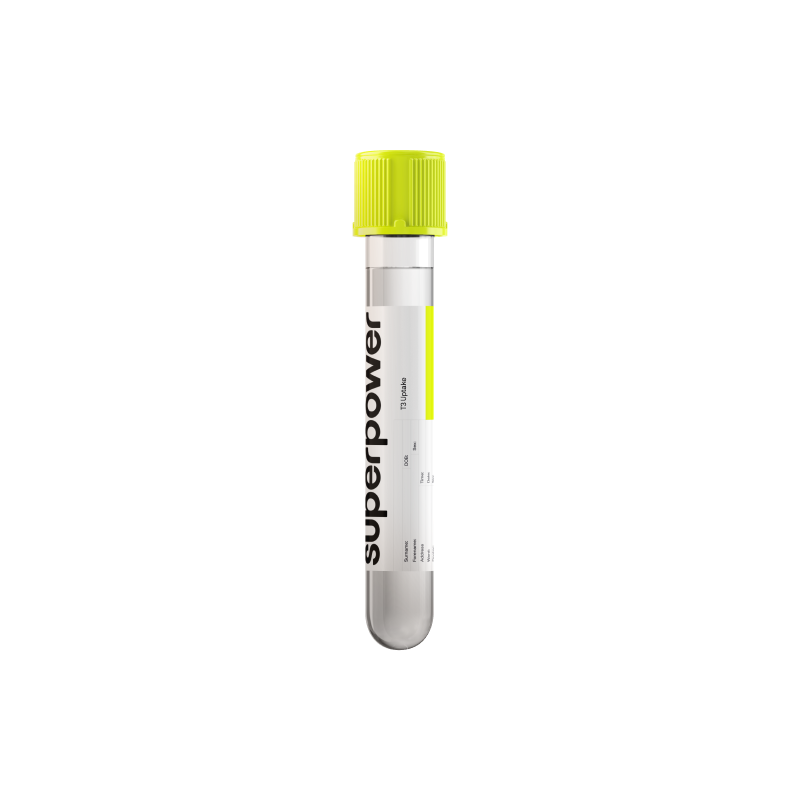T3 Uptake reveals how thyroid hormones interact with their carrier proteins in your bloodstream.
By showing whether binding proteins amplify or mask hormone levels, it helps distinguish true thyroid dysfunction from binding effects.
This clarity supports accurate diagnosis and more confident treatment decisions.
Key Benefits
- Understand thyroid hormone binding; this test does not measure T3 itself.
- Spot thyroid imbalance masked by protein changes like pregnancy or estrogen therapy.
- Clarify unusual labs when total T4 looks off due to binding shifts.
- Guide treatment by helping calculate the Free Thyroxine Index when needed.
- Flag conditions altering TBG, such as liver disease, nephrotic syndrome, or androgens.
- Support pregnancy care by adjusting thyroid interpretation for estrogen-driven binding increases.
- Track trends to distinguish real thyroid change from shifts in binding proteins.
- Best interpreted with TSH, free T4, and your symptoms for accuracy.
What is T3 Uptake?
T3 uptake is a blood test that estimates how many open “seats” remain on the proteins that carry thyroid hormones in your bloodstream. It does not measure the T3 hormone itself. Instead, it reflects the binding capacity of circulating carrier proteins made by the liver—primarily thyroxine-binding globulin (TBG), with contributions from albumin and transthyretin—that transport thyroxine and triiodothyronine (T4 and T3).
Most thyroid hormone travels bound to these carriers, while only the unbound portion (free hormone) can enter cells and do the work. T3 uptake mirrors how saturated those carriers are and, by extension, the context in which total hormone levels should be viewed. It provides an indirect window on the free, bioactive fraction and on the status of the binding proteins themselves. For this reason, it is often interpreted alongside total T4 to estimate free thyroxine availability (free thyroxine index).
Why is T3 Uptake important?
T3 Uptake estimates how many thyroid hormone “parking spots” on blood proteins are already occupied. It doesn’t measure thyroid hormone itself; it gauges the binding capacity of thyroid‑binding proteins (mainly TBG) so we can better infer the free, biologically active hormone that sets your body’s metabolic pace across brain, heart, muscles, gut, and temperature control.
Reference intervals vary by lab and method, and the result is best interpreted alongside total T4 or a calculated free thyroxine index. Values near the middle of the lab range usually reflect balanced binding and a reliable read on true thyroid status.
When the value trends lower, it means more empty binding sites are available. That happens when TBG is increased—common in pregnancy and with oral estrogens—or when the thyroid is underproducing hormone. Physiology slows: people with true hypothyroidism may notice fatigue, cold intolerance, dry skin, constipation, heavy periods, and slowed heart rate. By contrast, in pregnancy or estrogen use, tissues can be euthyroid despite a low result. Newborns and young children often have higher TBG and correspondingly lower uptake without disease.
When the value trends higher, binding sites are scarce. This occurs when TBG is reduced (androgen exposure, nephrotic protein loss) or when excess thyroid hormone saturates the protein in hyperthyroidism. Genuine hormone excess drives heat intolerance, weight loss, tremor, anxiety, and palpitations; low‑TBG states can show a high result while the person feels normal.
Big picture: T3 Uptake is a binding‑protein lens on thyroid physiology. Read with total T4/FTI, it helps separate true thyroid dysfunction from shifts in liver‑made proteins, kidney protein loss, and sex‑hormone effects—clarifying metabolic and cardiovascular risk over time.
What Insights Will I Get?
T3 Uptake (T3 resin uptake) does not measure T3. It estimates how many binding sites on thyroid-transport proteins, mainly thyroxine-binding globulin (TBG), are unoccupied. This matters because binding controls how much free thyroid hormone reaches cells, influencing energy use, temperature regulation, heart rhythm, mood, and fertility.
Low values usually reflect abundant unused binding capacity—more TBG or too little thyroid hormone (hypothyroxinemia). Estrogen states (pregnancy, oral contraceptives) raise TBG and lower uptake without true thyroid deficiency; in true hypothyroidism, low uptake accompanies low free hormone and slows metabolic rate, heart rate, bowel motility, and cognition.
Being in range suggests binding proteins and circulating hormone are in balance, so free hormone delivery to tissues is steady. Many labs see mid-range uptake aligning with euthyroidism, especially when total T4 and the free thyroxine index track accordingly.
High values usually reflect few unfilled binding sites—lower TBG or saturation by excess hormone. This appears with hyperthyroidism or reduced TBG from androgens, nephrotic syndrome, or severe systemic illness, and typically aligns with faster metabolism, heat intolerance, weight loss, tremor, and palpitations.
Notes: Interpretation depends on TSH and free T4/T3. T3 uptake is sensitive to changes in TBG (estrogens increase; androgens, liver or renal protein loss decrease) and to acute illness; methods vary across labs. It is often used to calculate the free thyroxine index, while modern practice leans on direct free hormone assays.



.svg)



.png)
.png)
.png)
.png)








